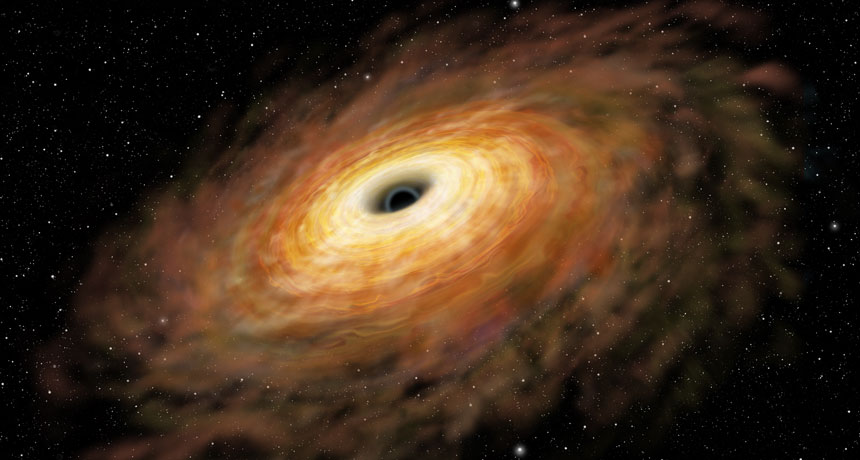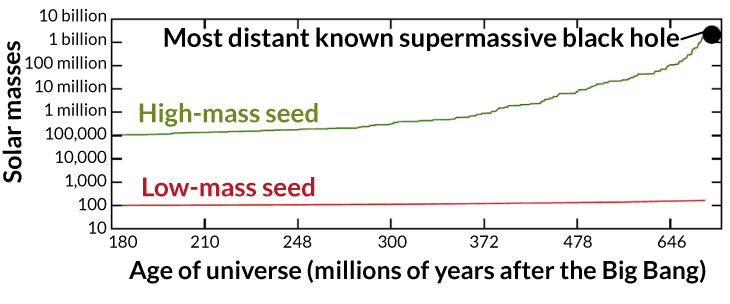
TOO BIG, TOO SOON Supermassive black holes that are actively feeding on gas and dust, like the one shown in this artist’s rendition, have been spotted in the early universe — before they should have had time to grow.
NAOJ
- More than 2 years ago
The existence of supermassive black holes in the early universe has never made much sense to astronomers. Sightings since 2006 have shown that gargantuan monsters with masses of at least a billion suns were already in place when the universe was less than a billion years old – far too early for them to have formed by conventional means.
One or two of these old massive objects could be dismissed as freaks, says theoretical astrophysicist Priyamvada Natarajan of Yale University. But to date, astronomers have spotted more than 100 supermassive black holes that existed before the universe was 950 million years old. “They’re too numerous to be freaks now,” she says. “You have to have a natural explanation for how these things came to be.”
The usual hypotheses are that these black holes were either born unexpectedly big, or grew up fast. But recent finds are challenging even those theories and may force astronomers to rethink how these black holes grow.
In the modern universe, black holes typically form from massive stars that collapse under their own gravity at the ends of their lives. They usually start out smaller than 100 solar masses and can grow either by merging with another black hole (SN: 3/19/16, p. 10) or by accreting gas from their environment (SN Online: 12/6/17).
That gas often organizes itself into a disk that spirals into the black hole, with friction heating the disk to white-hot temperatures that create a brilliant glow visible across billions of light-years. These black holes feeding on gas are called quasars. The faster a quasar eats, the brighter its disk glows.
But the glow from that gas also limits the black hole’s growth: The bright disk’s photons push away fresh material. That sets a physical limit on how fast black holes of a given mass can grow. Astronomers express how fast a black hole is eating with a term called the Eddington ratio, measuring the black hole’s actual brightness in relation to the brightness it would have if it were eating as fast as it possibly could.
Finicky feeders
Astronomers have measured Eddington ratios for only about 20 supermassive black holes in the early universe. Most seem to be eating at the limit, in contrast to quasars in the present-day universe that feed at about a tenth that speed. Those furious feeding rates still seem to defy the black holes’ supermassive size: A 100-solar-mass black hole accreting at the limit should take about 800 million years to reach a billion solar masses, even taking into account that it would eat faster as it grew. And that 800 million years doesn’t include the time it took the initial black hole seed to form.
But physicist Myungshin Im of Seoul National University in South Korea and colleagues worried that previous observations were missing pickier eaters because fast eaters are brighter and easier to spot. If some early massive black holes were lazy eaters, their super sizes become even more puzzling — and may rule out some theories for how they grew.
So the team deliberately sought out dimmer distant quasars in a September 2015 observing run at the Las Campanas Observatory in Chile.
The researchers found IMS J2204+0112, a billion-solar-mass black hole eating at a tenth of its speed limit and hailing from when the universe was about 940 million years old. But at its feeding rate, the black hole shouldn’t have fully matured until the universe was 8 billion years old, the team reported on arXiv.org February 9.
“We show for the first time that quasars with low Eddington ratio exist in the early universe,” Im says.
IMS J2204+0112 is the dimmest slow-eating quasar spotted yet, but it’s not alone. Physicist Chiara Mazzucchelli of the Max Planck Institute for Astronomy in Germany and colleagues reported 11 fussy supermassive black holes that existed when the universe was less than 800 million years old, in the Astrophysical Journal last November.
On average, those quasars weigh in at around 1.62 billion solar masses but eat at about 40 percent of the speed limit, the team reported. Strangely, the largest black hole in that group, HSC J1205-0000, had the lowest feeding rate: The black hole is 4.7 billion solar masses yet eats at only 6 percent of its limit.
It was strange enough to find supermassive black holes with gluttonous appetites in the early universe, but these picky eaters are even harder to explain.
Astronomers hope peering farther back in time will help find the “seed” black holes that may grow into behemoths. If some black holes started out huge, from 10,000 to a million solar masses, they could grow even larger either by merging with each other or accreting at the Eddington limit.
“If you start with such a very massive seed, you have a jump-start,” says astrophysicist Avi Loeb of Harvard University. “Then you don’t need as much time to grow to a billion solar masses.”
But theorists have been trying for 15 years to figure out how such huge black holes could form in the first place. One idea is that massive gas clouds or supermassive stars collapsed directly into a massive black hole.
Supermassive seeds
More recent work suggests it wouldn’t be that simple. Theoretical studies show it’s hard to prevent those gas clouds from fragmenting to form a cluster of small stars, rather than collapsing into one large star, says physicist Dominik Schleicher of the University of Concepción in Chile.
In the May 2018 Monthly Notices of the Royal Astronomical Society, Schleicher and colleagues show that such clusters also could create massive black hole seeds, as newly formed stars accrete gas left over in the cluster. Such stars could swell to 100 to 1,000 times the radius of the sun. Their inflated sizes and close proximity to one another would make these stars collide, triggering a domino effect that eventually collects all the stars in the cluster into a single supermassive star 10,000 times the mass of the sun. That supermassive star could then collapse to form a relatively massive seed black hole.
The other possibility is that early supermassive black holes simply broke the Eddington limit. They may have gone through periods of eating more quickly than was thought possible and grew to near-supermassive proportions before calming down.
Loeb points out that there are situations in the present-day universe where black holes eat faster than the Eddington limit, such as when they rip apart and devour a star (SN: 4/1/17, p. 5). There are also situations where radiation can be trapped near the surface of the black hole, preventing it from pushing material away. “In that case you can feed the black hole as fast as you want,” Loeb says.
Or, Natarajan and colleagues suggest, the answer could be both: Black holes that are born big get bigger faster. “Evidence is mounting slowly that we need to consider more than one way,” Natarajan says.
In a December 2017 study in the Astrophysical Journal Letters, she and her colleagues ran computer simulations showing that some environments can boost a black hole’s growth, allowing the black hole to consume a continuous stream of gas.
The rich get richer
Simulations show that a small black hole seed will never grow fast enough to become supermassive before the universe is a billion years old. But a black hole that was born large will grow faster and faster.

Still, only black holes born with masses at least 10,000 times that of the sun can grow to a billion solar masses within a billion years. But the most massive seeds are more likely to be born in a gas-rich environment.
“The environment around and the birth conditions for these black holes actually puts them on a track either for rapid growth spurts, or for rather slow growth,” Natarajan says. “The massive black hole seeds are the ones that won the birth lottery and got the best start in life.”
Ultimately, astronomers will need to see even farther back in time if they hope to find supermassive seeds. The James Webb Space Telescope, due to launch in 2019, should be able to detect quasars and stars at 400 million or 500 million years after the Big Bang. And a future gravitational wave observatory called LISA will aim to detect supermassive black holes across cosmic history.
“The only way to discriminate between these models is going back in time,” Natarajan says.







